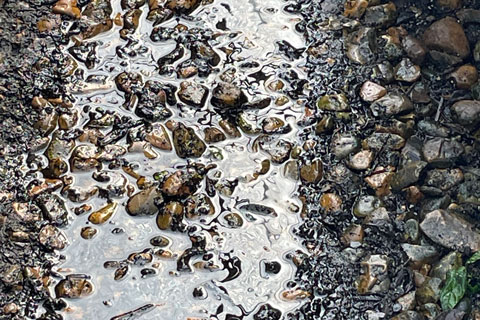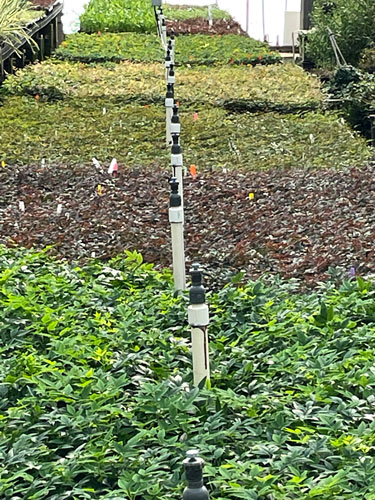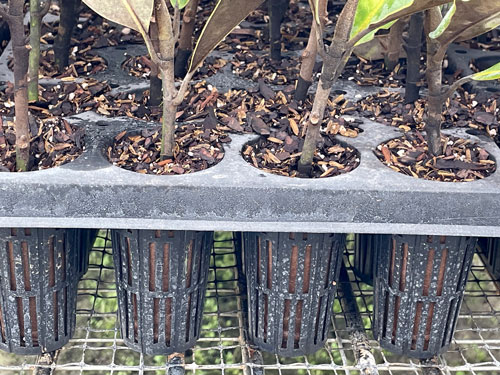11/1/2023
Common Propagation Mistakes
Lynn Griffith

Horticulture is an art as well as a science. Propagating plants vegetatively is even more of an art than growing in general. Sure, there’s research data on propagating the more common ornamental plants. However, variables such as variety, season, geography and structures can make large differences in what works and doesn’t work.
Overmisting—When you stick a cutting, it does one of two things: it roots or it rots. Those are really the only two outcomes. Plant propagation is a race between the two—can you get these cuttings to root before they rot?
Pictured: If there are pools of water under the benches or algae everywhere, you’re overmisting.
Mist propagation is popular for many cutting species. Some cuttings need a lot of mist. Some do better with none at all. Many growers overmist. When I walk into a mist house and hear water dripping or I see pools of water under the benches or algae everywhere, I know the propagator is overmisting. Mist is intended to prevent drought stress in the cuttings without drowning the media and rotting the cuttings.
Wrong mist heads—You see all kinds of mist heads used in the trade. Some are excellent, some are terrible. Many are really irrigation heads that put out way too much water than needed for prop. Some have irregular coverage patterns that leave dry spots in the propagation trays or beds, resulting in cutting loss. It’s usually best to keep mist times short and vary frequency according to environmental conditions and cutting age. Make sure pressure is adequate.
Irregular mist head height—Whether on risers or hanging from overhead, mist heads should be at exactly the same height. If they aren’t, the lower heads tend to drip between mistings, causing wet spots, washouts and disease. The pipes or tubes leading to the higher heads will fill with air. When the mist comes on, the lower heads start misting first while the higher heads are delayed as the pipes fill back with water. This leads to irregular misting, cutting loss and inconsistent cutting quality. All mist heads should come on and go off at the same time. The way you do that is have your heads at exactly the same height. Heads should also be placed close enough together so that the entire bench is covered, including the edges.
 Using the wrong media—Some growers try to propagate in their regular growing media to save money. This is usually a mistake. The physical characteristic of growing media versus prop media are different, as they should be. Propagation mixes usually receive much more water than growing media. They therefore need much better drainage and especially more pore space than growing media. Big pieces of bark in growing media can make it hard to stick cuttings. Usually some combination of peat, perlite and/or coir work well for propagation mixes.
Using the wrong media—Some growers try to propagate in their regular growing media to save money. This is usually a mistake. The physical characteristic of growing media versus prop media are different, as they should be. Propagation mixes usually receive much more water than growing media. They therefore need much better drainage and especially more pore space than growing media. Big pieces of bark in growing media can make it hard to stick cuttings. Usually some combination of peat, perlite and/or coir work well for propagation mixes.
Pictured: Whether on risers or hanging from overhead, mist heads should be at exactly the same height.
Wrong time of year—Time of year for propagation affects carbohydrate and nutrient content in cuttings, which can affect cutting performance. It can also affect light levels and, of course, temperature. Many varieties have sweet spots for the best months to propagate, while others do not. Unfortunately, the best propagation months in one part of the country can be way different than in other parts of the country. Cuttings can take 40% more time or longer to root in the winter months as opposed to summer.
Wrong cutting size or type—Some varieties root better from green, fresh tip growth; others do better from semi-hard wood, while others do best with mature wood. Caliper of stem cutting can make a huge difference, as can overall cutting size and number of leaves. Observe which types of cuttings are rooting best in your situation. It may or may not be worth the labor to reduce leaf size in order to reduce transpiration. Having leaves overlap each other by sticking cuttings too close can limit mist coverage. It’s usually best to remove buds or flowers from flowering varieties, as the flowering process takes “energy” from the cuttings.
Stressing cuttings before sticking—Too often I see propagation crews collect large quantities of cuttings from production plants in the field. By the time the last cuttings of the batch are collected, the first ones have already begun to wilt. Once you drought-stress a cutting, it’s hard to reverse that stress. You’re better off collecting cuttings in smaller batches. Don’t let baskets of cuttings sit in the sun or heat while they wait to be stuck. If you must, toss them on a bench under mist heads to avoid wilting during the sticking process.
Wrong hormone rate or type—Rooting hormone products are popular because they often reduce rooting time and cutting loss. However, the strength or rate used can be critical and can vary widely. For rooting of magnolia cuttings, I’ve seen sources recommending from 3,000 ppm IBA to 50,000 ppm IBA. That’s a 28.6-fold difference and everything in between! Propagators should trial different rates for their real-world situation. While IBA is the most popular rooting hormone, others may be helpful or better. There’s a report that magnolias root much better when you add NAA to the IBA. Dipping in hormone powders is popular, but can be labor intensive. Liquid products can sometimes be more efficient.
Wrong temperature—Air temperature, mist water temperature and media temperature can all affect propagation success in positive and negative ways. A hot or overly sunny prop house can stress cuttings and cause huge losses from drought stress. Cold mist or chilly substrate can cause cuttings to take forever to root (see Overmisting). Bottom heat raising media temperature can be very effective at times in speeding rooting and increasing rooting percentage.
 Using nutrient mist—While I have a couple of consulting clients who do this successfully, injecting fertilizers into mist water is risky. First, soluble salts can build up in the prop media. This drought-stresses cuttings, which are already stressed. It can lead to disaster. Second, nitrogen and phosphorus in the mist water can lead to algae growth on the media surface and under the benches. This can lead to fungus gnat problems. We may call them fungus gnats, but they really love algae.
Using nutrient mist—While I have a couple of consulting clients who do this successfully, injecting fertilizers into mist water is risky. First, soluble salts can build up in the prop media. This drought-stresses cuttings, which are already stressed. It can lead to disaster. Second, nitrogen and phosphorus in the mist water can lead to algae growth on the media surface and under the benches. This can lead to fungus gnat problems. We may call them fungus gnats, but they really love algae.
Pictured: For rooting of magnolia cuttings, sources have recommended from 3,000 ppm IBA to 50,000 ppm IBA. That’s a 28.6-fold difference!
Inadequate fungus gnat management—It takes a lot of labor to stick a tray of cuttings. We all know that nursery labor is getting more expensive and harder to find. Unless propagators are vigilant, fungus gnats can wipe out entire benches of cuttings. They often feed on the base of cuttings. The cutting can’t transfer enough hormone further up the stem in time and the cutting will rot. Fungus gnats also spread diseases, which can affect liners even after they root. Monitor prop beds with yellow sticky cards and treat with insecticides where appropriate.
Not applying adequate or proper fungicides—The air and water environments in prop houses are usually ideal for disease development. You have high moisture, high temperatures, high humidity, lower light—everything your favorite plant pathogen loves. You may (should) sterilize your cutting tools in prop, but there’s nothing sterile about your media, mist water, structure or hands. The big four (Pythium, Phytophthora, Rhizoctonia and Fusarium) can all be there, along with Erwinia and other bacteria. Dipping cuttings prior to stick and periodic sprays or drenches (preferably when the mist is done for the day) can mean the difference between a house full of rooted liners and a dumpster full of dead cuttings. (And then you have to start all over again!)
Not attending IPPS meetings—The International Plant Propagators Society can be a great source of information for propagators. You can hear about the latest research updates, mingle with people of your own kind, share tips, experiences and ideas, and make friends and contacts. They have regional and national meetings that are well worth attending. GT
Lynn Griffith is a tropical plant and soil expert based in Boca Raton, Florida.